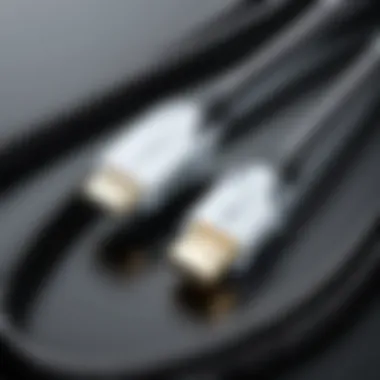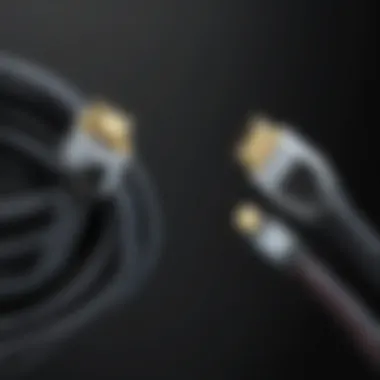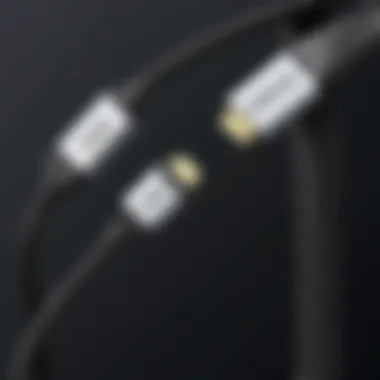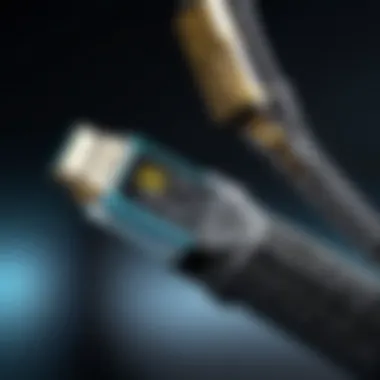Best Braided HDMI Cables: An In-Depth Analysis


Intro
In today’s digitally-driven world, high-quality video and audio transmission is vital. As technology progresses, the need for dependable connectivity options grows, and HDMI cables have proven to be a cornerstone for transmitting signals between devices. Braided HDMI cables are becoming increasingly popular due to their robustness and aesthetic appeal.
When choosing the right HDMI cable, many users, especially IT professionals and tech enthusiasts, face a myriad of options. This article aims to break down the complex elements that make up the best braided HDMI cables on the market. We will explore their construction, advantages, and critical features that set them apart.
From understanding the specifications to evaluating performance metrics, we will provide insights that help in selecting the ideal cable for various applications. Furthermore, we will review specific products based on user feedback and expert evaluations, ensuring a well-rounded perspective to inform purchasing decisions.
Let’s dive deeper into these essential connections and discover what sets the finest braided HDMI cables apart from the competition.
Understanding HDMI Cables
HDMI cables have become a cornerstone in the world of audio and visual technology. Understanding their design and functionality is essential for anyone looking to optimize their media setups. Their primary function is to transmit high-definition video and audio signals between devices, such as televisions, gaming consoles, and computers. This makes them crucial for both home entertainment and professional environments.
In the landscape of technology, the gradual advancement of HDMI cables represents a significant leap in how we consume media. With various versions released over the years, each brings enhancements that cater to evolving needs—from support for higher resolution outputs to increased bandwidth. This understanding can help avoid compatibility issues, ensuring a seamless experience across devices.
The Evolution of HDMI Technology
From the time of its introduction in 2003, HDMI technology has undergone remarkable changes. Originally designed to simplify connections, it has flourished into multiple iterations, enhancing both functionality and performance. Early versions supported standard-definition video but soon adapted to accommodate the growing demand for high-definition content.
By 2010, HDMI 1.4 was released, introducing support for 4K resolution and 3D video formats. This version was a game-changer, especially for consumers investing in modern TVs and projectors. Fast forward to HDMI 2.1, which arrived in 2017, and we see support for even more advanced features like dynamic HDR and an impressive bandwidth of 48Gbps. The evolution of HDMI reflects the fast-paced nature of technology and the ongoing quest for superior visual and audio experiences.
HDMI Versions and Their Impact
Understanding the various HDMI versions is crucial for making informed decisions when purchasing cables. Each version brings specific features that cater to particular needs. Here’s a rundown of major HDMI versions and their impacts:
- HDMI 1.0: The original version, supporting 1080p video and basic audio formats.
- HDMI 1.4: Added support for 3D content and 4K resolution, marking significant improvements suitable for home theaters.
- HDMI 2.0: Increased the bandwidth to 18Gbps, enabling 4K at 60 Hz—ideal for gaming and high-definition video streaming.
- HDMI 2.1: Currently the gold standard, allowing for 8K resolution and advanced features such as Variable Refresh Rate (VRR) and Enhanced Audio Return Channel (eARC).
The introduction of each HDMI version illustrates how manufacturers have aimed to keep pace with advancements in display technology and consumer expectations. As devices become capable of producing higher-quality output, the associated HDMI cables must also evolve to meet these demands.
Why Choose Braided HDMI Cables
In a world brimming with digital gadgets and ever-evolving tech, the choice of cables might seem trivial to some. However, when it comes to connecting devices like televisions, gaming consoles, or sound systems, the right cable can make all the difference. Braided HDMI cables have gained traction among IT pros and tech lovers alike for various compelling reasons. This section dives into the weighty benefits and for opting for these cables over their standard counterparts.
Durability Compared to Standard Cables
Durability stands out as a key consideration when choosing any cable, and braided HDMI cables excel in this area. Unlike the standard plastic-coated cables, the braided exterior offers a level of protection that is hard to beat. This sturdiness is not just for show; it’s about preserving signal quality and longevity.
In day-to-day usage, cables can be subject to wear and tear. From harsh bends to unintentional tugs, damage can lurk around every corner, waiting for an opportunity to shorten a cable's life. Standard cables are often susceptible to fraying, breaking, or losses in signal, which can be frustrating.
Braided HDMI cables, however, are much more resistant to these forms of damage. The braided material acts as a shield, providing a barrier against the rigors of life. Whether you’re connecting a high-definition projector for work or setting up a home theater, knowing that your cable can withstand a bit of rough handling offers peace of mind.
Additionally, many braided cables incorporate high-quality connectors that ensure a firm fit and contribute to the overall resilience, which is a boon for anyone who regularly connects and disconnects their devices.
Aesthetic Appeal and Practicality
Looks may not be everything, but let’s face it: we live in a visually driven world. The aesthetic appeal of braided HDMI cables is another noteworthy factor that turns the head of potential buyers. The varied colors, patterns, and textures not only make these cables stylish but also leave a lasting impression.
Picture this: you’ve got a sleek modern setup with a minimalist design. Here comes a bunch of standard, rubbery black cables that clash with the vibe. Not quite right, is it? Braided cables, on the other hand, can enhance the ambiance of your space. They blend with your devices seamlessly and can sometimes even become an extension of your interior design.
But there’s more than just looks; practicality comes into play as well. Braided cables tend to be less prone to tangling, making setups a breeze to manage. With fewer trips to untangle a mess of cables, users can spend more time enjoying their tech, which is what it’s all about, right?
In summary, the decision to choose braided HDMI cables is not just about their aesthetics but also about their practical benefits. It’s a win-win scenario where you get durability, style, and ease of use all wrapped into one neat package.


"Choosing the right cable is just as important as picking the right device. A high-quality HDMI cable can enhance your entire viewing experience."
With that being said, when you’re gearing up for your next tech purchase, don’t overlook the value braided HDMI cables bring to the table.
Key Features of Quality Braided HDMI Cables
When considering the best braided HDMI cables, several critical features stand out. These features not only dictate performance but also enhance the overall user experience. Understanding these elements helps IT professionals and tech enthusiasts make informed decisions that cater to their specific needs.
Conductor Quality and Material
The conductor quality in HDMI cables directly impacts the efficiency of signal transmission. High-quality conductors, such as those made from pure copper, minimize resistance and enhance clarity, ensuring that high-definition signals are preserved without degradation over distance. It's noteworthy that using materials like aluminum can lead to a compromise in performance, often resulting in pixelation or lag during streaming.
To guarantee the best performance, look for cables that boast gold-plated connectors. These provide better conductivity and resistance to corrosion. Furthermore, tinned copper is another material option that provides an interesting balance between affordability and quality. Essentially, it protects against environmental factors without excessively inflating costs.
Cable Length Considerations
Length plays a vital role when selecting HDMI cables. Generally, shorter cables deliver superior signal quality since they reduce the likelihood of interference over distance. However, for setups that require longer runs, it's essential to verify that the cable supports the required specifications, whether that’s 4K, HDR, or any other high-definition standard.
As a rule of thumb, if you need a length beyond 25 feet, consider investing in an active HDMI cable. These cables contain signal boosters, which help maintain clarity and reduce potential loss in transmission. The thought process should also include the layout of your space; sometimes, neat cable management can make a longer cable feasible without compromising the aesthetic.
Connector Build and Design
The connector build is another area that should not be overlooked. A well-constructed connector ensures a robust link between your devices, decreasing the chances of disconnection or damage. Look for gold or nickel-plated connectors as they enhance conductivity and hinder rusting. Durability in design becomes crucial, especially for users who frequently plug and unplug cables.
In addition, a strain relief design is another aspect worth checking. This is essentially the flexible portion of the cable that extends close to the connector. It helps to prevent wear and tear, thereby prolonging cable life. Moreover, aesthetically, braided cables often come with added protective layers that blend durability with design. A product that is both functional and visually appealing is usually a hit among tech enthusiasts.
"A quality HDMI cable is like a sturdy bridge; it connects and enhances your tech journey without interruption."
Performance Analysis
When diving into the world of HDMI cables, particularly braided types, performance analysis is paramount. This section explores how well these cables perform in various scenarios and why their characteristics matter to tech which enthusiasts and IT professionals alike. Understanding performance encompasses more than just the physical attributes; it encompasses functionality, longevity, and adaptability when interfacing with different devices.
Signal Transmission Quality
Signal transmission quality is the backbone of any HDMI cable’s functionality. It refers to how effectively data travels from one device to another. A superior braided HDMI cable minimizes signal degradation, ensuring that users experience crisp visuals and clean sound without interruptions. High-quality cables often feature a high bandwidth capacity, enabling them to support various resolutions, including 4K and 8K, along with HDR formats.
Some notable factors influencing signal transmission quality include the
- Conductor material – Generally, a copper-based conductor will outperform others like aluminum in transmitting signals due to its lower resistance.
- Shielding – Effective shielding protects against electromagnetic interference, which can severely impact the data integrity.
Ultimately, a high-performing HDMI cable guarantees that the user's investment isn't overshadowed by poor connectivity.
Compatibility with Various Devices
To maximize the utility of braided HDMI cables, compatibility across devices is essential. Let's break down how these cables perform with popular devices:
Televisions
Televisions serve as one of the primary devices where HDMI cables shine. When connected to modern 4K or Smart TVs, a quality braided HDMI cable enhances the viewing experience by supporting high-resolution video signals. The key characteristic here is the cable’s ability to handle the required bandwidth. Some TVs may also have specific HDMI ports optimized for different connectivity, which calls for a cable that can effectively communicate across various formats without a hitch.
A unique feature of many televisions today is the implementation of HDMI ARC (Audio Return Channel). This allows audio signals to travel back from the TV, which can be used for sound systems. For gamers or movie enthusiasts, this means fewer cables cluttering up the entertainment setup.
Projectors


Projectors are another area where the quality of the HDMI cable is crucial. A capable braided HDMI cable maintains a strong signal even over longer runs, which is often necessary in presentation or home cinema settings. The ability to project high-definition images makes these cables a beneficial choice for serious users aiming for a professional-level experience.
An essential feature of many projectors includes the support for interactive presentations, where signal latency can be a significant drawback. A reliable cable can help ensure minimal delay, which is invaluable during crucial live demos or performances.
Monitors
In the realm of Monitors, particularly for graphic designers or data analysts, the fidelity of the signal is critical. Using a high-quality braided HDMI cable can make all the difference in translating the full spectrum of colors from a computer system to the monitor.
Many modern monitors boast higher refresh rates and resolutions, all of which demand cables that don't falter. Additionally, with the advent of multi-monitor setups, cables that allow for easy switching between devices without loss of signal or quality are highly sought after among professionals.
Gaming Consoles
Last but not least, Gaming Consoles require robust cables for an optimal gaming experience. These consoles often come equipped with capabilities for 4K gaming or high frame rate output. Here, the HDMI cable's performance directly impacts how gamers experience graphics and game play.
A unique feature of most modern gaming consoles is support for variable refresh rate (VRR) technologies, which requires a cable that can handle fast, fluctuating signals. Gamers benefit greatly from these features as they reduce input lag and screen tearing, making for a smoother gaming experience. Thus, choosing the right braided HDMI cable becomes crucial not just for connectivity, but for enhancing overall performance.
Top Recommendations for Braided HDMI Cables
When it comes to choosing the best braided HDMI cables, one has to navigate a marketplace filled with myriad options, each with its own set of features and benefits. In this section, we're going to delve deep into the top recommendations, breaking down each into premium picks and budget-friendly choices. This exploration is crucial because selecting the right cable can significantly impact the quality of your audio-visual experience. A good HDMI cable not only ensures high-definition signal transmission but also provides durability and versatility, making it an essential component of any tech setup.
Premium Options
Brand A
Brand A has positioned itself as a leader in the HDMI cable industry, renowned for its robust construction and excellent signal quality. One of its key characteristics is the exceptional durability offered by its braided exterior. This specific aspect makes Brand A a popular choice among IT professionals and tech enthusiasts who require reliable performance over long periods.
A unique feature of Brand A’s cables is their gold-plated connectors, which are designed to minimize signal loss. The advantage here is clear: with a low rate of interference, users experience crisper images and clearer audio. However, the premium price tag attached to Brand A’s offerings might not sit well with every budget.
Brand B
Brand B emerges as another strong contender in the braided HDMI cable realm. Not only are these cables built to last, but they also boast fast data transmission speeds, making them suitable for high-performance setups such as gaming consoles and professional media work.
A standout feature of Brand B is its tangle-free design, enabling easier handling and storage. Users often appreciate how this minimizes wear and tear, consequently extending the product's lifespan. The trade-off, however, is that some may find Brand B’s aesthetics less appealing compared to other brands.
Budget-Friendly Choices
Brand
When considering budget options, Brand C commands attention. It offers a remarkable balance between price and performance, making it an appealing choice for those who are conscious of their spending but still want quality. A primary aspect that stands out about Brand C is its user-friendly design, catering to tech novices and experts alike.
The unique feature of Brand C’s braided cables is their vibrant color options, which allow users to add a personal touch to their setups. While they may lack some of the advanced features found in premium products, the affordability combined with decent durability makes Brand C a favorite for casual users.
Brand
Rounding out this budget-friendly category is Brand D, known for its no-frills approach. This brand provides basic HDMI functionality without excessive embellishments, which can often bloat the price tag.
Brand D’s key characteristic lies in its straightforward design and ease of use. For those who simply want a reliable cable without the bells and whistles, Brand D becomes a solid choice. However, some users have complained about its relatively short lifespan compared to pricier alternatives. It’s an effective solution for those not facing heavy-duty usage.
"Choosing the right HDMI cable can make a world of difference in your audio-visual experience. Don’t overlook the benefits of investing in quality."
As we navigate through these top recommendations, the consideration between premium options and budget-friendly choices ultimately hinges on personal needs, performance expectations, and economic factors. Each of these brands represents specific strengths that could make them a perfect fit for varied applications.
User Feedback and Market Trends


Understanding user feedback and market trends is vital in the realm of HDMI cables, especially when it comes to braided options. These cables serve as a lifeline between devices, and their performance directly impacts the user experience. This section delves into how user insights shape expectations and how market trends signal changes in technology.
Users often share their experiences, highlighting what works and what doesn't in real-world scenarios. Collectively, this wealth of information guides potential buyers in their choices, ensuring they don’t end up with subpar products. The importance lies in the nuances of everyday usage: through reviews and discussions, users reveal issues like cable tangling, fraying, or signal loss that may not be evident from technical specs alone.
Common User Experiences
In looking at common user experiences, a few themes consistently emerge:
- Durability: Many users praise the durability of braided HDMI cables compared to traditional PVC ones. They often mention how the braided design provides extra protection against wear and tear. This is especially relevant for users who frequently plug and unplug their devices or those with pets that could easily chew on cables.
- Signal Quality: Users frequently report that braided HDMI cables tend to maintain signal integrity better than cheaper alternatives. Reviews often point to the superior construction as a reason for fewer dropouts or glitches during playback.
- Aesthetic Preferences: The visual appeal of braided cables also pops up in user feedback. Many find them more attractive and professional-looking, especially in home entertainment setups where visible cables can detract from the overall design.
- Price versus Performance: A typical debate among users is the balance between price and performance. Many have shared feelings of regret after purchasing lower-cost cables that led to performance issues, reinforcing the idea that investing in quality braided HDMI cables pays off in the long run.
"I started buying the cheapest cables, and it was a false economy. Now, I always go for a braided one, it just works better!"
— A recent Reddit discussion on HDMI cable choices
Emerging Trends in HDMI Technology
As technology evolves, so do HDMI cables and their associated trends. A few emerging paths are worth noting:
- Higher Resolutions: With 4K and even 8K displays entering the consumer market, cables are being designed to handle increased bandwidth for better signal integrity. Users are beginning to seek HDMI cables that explicitly mention support for these higher resolutions and refresh rates.
- Smart Capabilities: There’s a growing interest in smart HDMI cables that can provide diagnostic information. These cables can indicate if they are functioning optimally, providing peace of mind to users who value performance metrics.
- Sustainability: With an increasing focus on eco-friendliness, some brands are starting to advertise braided HDMI cables made from recycled materials. Users express appreciation for options that align with their values on sustainability, influencing purchasing decisions.
- Versatile Compatibility: As the market for electronic devices expands, there’s a significant push towards cables that can connect a broader range of devices seamlessly. Users want assurance that their chosen cables will work across multiple devices, from home theater setups to gaming consoles.
Installation and Maintenance Tips
Proper installation and maintenance of braided HDMI cables can significantly affect their performance and longevity. Given the investment often made in high-quality apparel, understanding how to handle and care for these cables ensures you get the most out of your purchase. Not only does it help in sustaining the quality of signal transmission, but also minimizes wear and tear over time, keeping you connected without a hitch.
Proper Handling Practices
When dealing with braided HDMI cables, the way you handle them matters more than you might think. Here are some essential practices:
- Avoid Sharp Bends: These cables are sturdy, but sharp kinks can still compromise the internal wiring. Always aim for gentle curves when routing the cable.
- Use Cable Ties Wisely: If you need to secure the cables, use soft ties that won't tighten too much. This prevents unnecessary pressure on the cable.
- Store Carefully: When not in use, do not just toss the cables into a drawer. Ideally, store them coiled in a way that avoids any stress on the connectors.
- Keep Away from Heat Sources: Excessive heat can damage the cable materials over time, so make sure they’re kept away from hot appliances or direct sunlight.
"Proper handling of cables is half the battle won; it prolongs their life and reliability."
Troubleshooting Common Issues
Even the best cables may sometimes face issues, and knowing how to troubleshoot can save you unnecessary hassle. Common problems include:
- No Signal: If your device shows no signal, check if the cable is securely connected. Sometimes, it simply needs to be re-seated.
- Poor Picture Quality: This could be due to damaged connectors or cable damage. Inspect closely for any visible wear.
- Incompatibility with Devices: Certain older devices may not recognize newer HDMI standards. Research if your equipment is updated and compliant.
To resolve these issues, it might be useful to have a few spare cables on hand. If a particular cable seems faulty, try swapping it with another one to rule out any device-related problems.
Staying educated about proper installation and maintenance of your braided HDMI cables not only keeps your devices connected and functional but also enhances the overall tech experience. Remember, a little care goes a long way.
Culmination and Final Recommendations
As we bring this exploration of braided HDMI cables to a close, it is essential to synthesize the information gathered throughout the article. Braided HDMI cables are not just about aesthetic appeal; they also embody significant advantages in durability and performance, making them a noteworthy investment for any tech-savvy individual or IT professional.
Weighing Your Options
When deciding on a braided HDMI cable, several key factors must be weighed. Firstly, consider the length of the cable you need. Longer cables can introduce signal degradation, so finding the right balance between length and quality is crucial. Also, pay attention to the connector quality — poor connectors can lead to connectivity issues. Many users have noted that copper conductors often outperform gold-plated options in certain conditions, particularly in terms of signal transfer in standard environments.
Indeed, not all braided HDMI cables are created equal. Take your time to research and read user feedback. Sometimes, spending a bit more on a reputable brand can save you hassle down the road.
"Choosing the right HDMI cable isn't just about function; it's about ensuring the tech works seamlessly for you."
Moreover, ensure the cable you choose is compatible with your devices. If you are using a gaming console, make sure the cable supports the resolutions and refresh rates available for optimal performance. The future of connectivity hinges on versatility, and the right cable should be equipped to handle various setups without a hitch.
Future Developments in Cable Technology
The future of cable technology is evolving rapidly, and HDMI is no exception. With HDMI 2.1 now making its mark, advancements promise higher bandwidth capable of supporting resolutions up to 10K. This demands a re-examination of existing cables as the market gravitates toward higher specifications. Moreover, we're seeing an increase in cables built with advanced shielding methods to reduce interference from other devices, which is becoming more pertinent in today’s tech-infused environments.
Manufacturers are also exploring new materials that promise improved durability and flexibility, aimed at catering to the multifaceted lifestyles of users. Expect to see braided cables that are not only resilient but also lightweight and portable, striking a harmony between practicality and performance. Those trends hint at a bright horizon for HDMI technology, meaning today’s choices may quickly become obsolete tomorrow.



